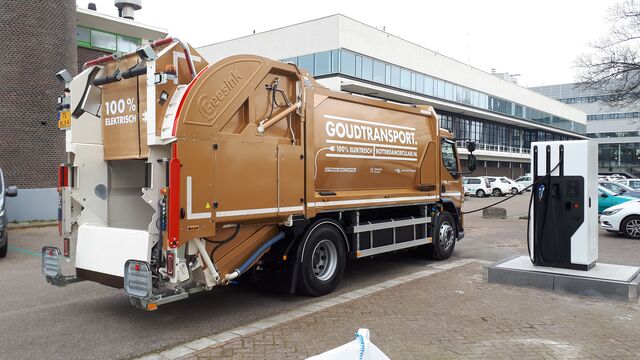Electromobility : Electric Trucks for Waste Collection: Let's jump on the e-Train

Trucks are an integral part of waste management. We use them to collect and transport solid waste, organics and recyclables to the processing plants. They help pave the way to sustainability. But they themselves are mostly powered by diesel. So here is where the sustainability ends. Or is it?
Because the future of trucks looks quite – electric. Now that basically every car company is developing electric vehicles, truck manufacturers are also jumping on the e-train. The demand is being driven on the one hand by large fleet owners like Ikea, Pepsi, Anheuser-Busch and Amazon and on the other by government policies. The EU, for example, has set a target of banning the sale of new petrol and diesel cars by 2035 as part of its Fit for 55 decarbonisation plan. And members of the EV100 initiative have committed to adopting zero-emissions fleets by the year 2030. So it’s no wonder that garbage truck manufacturers have also joined the worldwide trend. From BYD to Mack Trucks (a subsidiary of Volvo), Renault and e-Trucks Europe, all have prototypes or early production models in the pipeline.

Riding the E-Train
Cities seem to welcome the zero-emission garbage trucks. In 2020, New York started testing the first full-sized electric Mac LR garbage truck. The city plans to put 2,000 e-vehicles in service by 2025. In the UK, Westminster City Council in London together with its waste contractor Veolia introduced a 60-strong fleet of what they call “upcycled” e-vehicles in October last year. For this project, diesel trucks have been retrofitted with an electric engine.
Also in 2020 the first electric garbage truck, a Volvo FF Electric, started its service in Munich, Germany. By 2030, the city of Munich and the waste disposal company plan to convert the fleet of around 250 heavy vehicles to climate-neutral drives and fuels.
In Vienna, Austria, two specially-built electric garbage trucks have been in operation since 2019. “To produce the vehicle, e-truck manufacturer Framo converted a conventional truck cab mounted on a MAN waste collection truck chassis to electric operation. MUT then added the waste collection and compacting unit,” explains Martina Ableidinger, head of public relations of Vienna waste management.
The experiences so far have been mostly positive. The driving comfort compared to conventional refuse collection vehicles is far better, according to the truck drivers: the advantages include jerk-free starting, smoother acceleration and a very precise dosage of speed.
What surprised the Vienna waste management company was that the battery’s performance has not deteriorated so far. “Very high or low temperatures can affect the capacity of a battery. However, the experience gained so far in real operation has not yet shown any negative effects due to the prevailing temperatures,” says Martina Ableidinger. In real-life operation, it was shown that daily use can be managed well with one charge. In addition, a relatively low charging power of 11 kW is sufficient to charge the vehicle.
On Silent Wheels
Apart from the fact that e-trucks don’t produce any local emissions, they operate more or less silently, at least up to 25 km/h. They are relatively low maintenance because they have fewer components and the fact that there is no exhaust aftertreatment. Due to their low centre of gravity, there is no danger of them tipping over.
But of course, there are no advantages without disadvantages. The high purchase costs, more than twice the cost of a diesel truck, are still an issue. And the lack of availability of special vehicles on the market surely doesn’t help. “They also still have a low range and cannot be used for long-distance routes,” Martina Ableidinger adds.
Little Hiccups
In the city of Rotterdam, Netherlands, there are currently three e-trucks for waste collection in operation: one rear loader each from EMOSS and Volvo as well as a vehicle with a crane for containers from VDL. There are regular meetings with the producers to discuss feedback, explains Patrice van Houten, project lead at the municipality of Rotterdam.
Even though the waste management services are happy with the driving comfort and general quietness of the trucks, they do notice start-up problems. “Most of them are the first production units, so this is to be expected,” says Johann Visser, who advises the City of Rotterdam. “As yet, the battery capacity is too low to drive two shifts. At times it is not even possible to do an entire shift, so it is difficult to schedule the routes.” The service is more difficult because of the lack of experience, but Visser expects lower maintenance costs in the future. Rotterdam holds regular consultations with the four biggest cities in the Netherlands as well as with its neighbours to discuss the experiences and plans regarding the emissions-free fleet.
The product is beautiful but the capacity will have to be increased so that they can deliver the requested work package. We are still in the development phase.Patrice van Houten, Rotterdam CCG
Necessary Improvements
Because of the low energy density, the weight of the battery is relatively high, resulting in a loss of load capacity. “Improvements are not only needed regarding the battery capacity and power density but also in infrastructure development, charging management and price,” agrees Martina Ableidinger. The production of the truck batteries is still very energy-intensive and then of course there is the problem of recycling the battery.
Emissions-Free Truck Fleet
As mentioned above, within the EU it will be necessary for municipalities to replace their truck fleets with emissions-free vehicles by 2030. But is this even realistic? “This depends on the availability of e- and H2 trucks, the money, the availability of sufficient electric energy at our working locations and the availability of H2 gas stations,” explains Johann Visser, pointing out that the future might be emissions-free but won’t just be electric.
“It will probably be a mixture of different types of drive, as no one type of drive has yet emerged,” agrees Martina Ableidinger. “But e-waste vehicles as well as fuel cell waste vehicles or synthetic fuel vehicles or biogas vehicles all have their credentials and would be conceivable as waste collection vehicles. The availability on the market will play an important role in the decision-making process.”
Patrice van Houten puts it in a nutshell: “The product is beautiful but the capacity will have to be increased so that they can deliver the requested work package. We are still in the development phase.”


